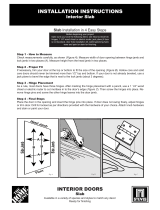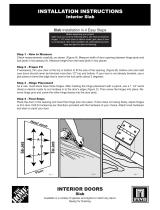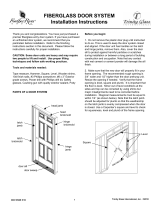© 2014 Trinity Glass International, Inc.
DOCIINDX 02/14
INSTRUCCIONES DE ACABADO
Preparación de su nueva puerta para el acabado
1.! Enmascare o retire todos los accesorios (bisagras, pomos,
etc.). Cubra el vidrio si corresponde antes de pintar o
barnizar.
2.! Lije toda la superficie suavemente con un papel de lija 5/0
(grano 180) antes de aplicar la primera capa de acabado.
Lije siempre en el sentido de las vetas de la madera, vea
la Figura 4.
3.! Limpie el polvo y los restos de la lija de la puerta con un
paño limpio. Evite el uso de limpiadores abrasivos o
cáusticos.
MUESCA PARA EL ORIFICIO DE LA CERRADURA
1. Se puede retirar la puerta de las bisagras para recortar el
orificio de la cerradura y la muesca con mayor facilidad.
Ubique el centro del orificio de la cerradura y el orificio del
borde de su puerta actual y transfiera las medidas a su
puerta nueva. Use la distancia entre el borde y los orificios
recomendada de su nueva puerta o la distancia existente de
su puerta actual. Perfore el orificio de la cerradura y el orificio
del borde como se muestra en la Figura 3.
2.! Use la placa frontal como plantilla y colóquela sobre el centro
del orificio del borde. Tome un lápiz y realice un trazo
alrededor de la placa. Marque con una hoja de afeitar y
cincele suavemente para quitar la madera hasta alcanzar una
profundidad suficiente como para que la placa quede
empotrada en la muesca.
Figura 3
ORIFICIO DE LA
CERRADURA
ORIFICIO DEL BORDE
MUESCA PARA
LA PLACA FRONTAL
2
5. Una la puerta a las bisagras con tornillos para madera de
cabeza plana Phillips #10 x 1". Asegúrese de que la puerta
abre y cierra libremente sin unión ni roce. Si hay roce o
contacto entre la puerta y la jamba, use un cepillo para
retirar madera del área. Recuerde que las puertas de
madera se expandirán durante épocas de gran humedad.
Si la puerta se atasca, es probable que deba ajustarla al
colocar cuñas delgadas de madera o cartón entre la puerta
y las hojas de la bisagra.
Barnizado/Acabado de su puerta de madera
1. Complete los pasos 1 a 3 para preparar su nueva puerta
para el acabado. Aplique una capa base de presellador
en los seis lados de la puerta antes de barnizar. Eso es
especialmente importante en las puertas de pino y arce.
2. Barnice la puerta hasta obtener el color deseado
siguiendo las instrucciones del fabricante del barniz.
Barnice siempre en el sentido de las vetas de la madera,
vea la Figura 4.
3. Para obtener mejores resultados, aplique al menos dos
capas claras de brillo sobre el barniz, lijando suavemente
entre las capas. Use papel de lija 6/0 (grano 220) o más
fino. Asegúrese de que el barniz y el brillo son materiales
compatibles.
Pintura de puerta imprimada
1. Complete los pasos 1 a 3 para preparar su nueva puerta
para el acabado. Aunque la puerta imprimada no requiere
lijarse antes del acabado, un lijado suave (grano 180) le
brindará una adhesión óptima de la pintura.
2. Acabe la puerta con dos capas de pintura látex, al óleo o
laca. Asegúrese de que la puerta se seque por completo
entre las capas en los seis lados de la puerta. Pinte siempre
en el sentido de las vetas de la madera, vea la Figura 4.
Figura 4
Nota: siga siempre
las instrucciones
para barnizar del
fabricante.






